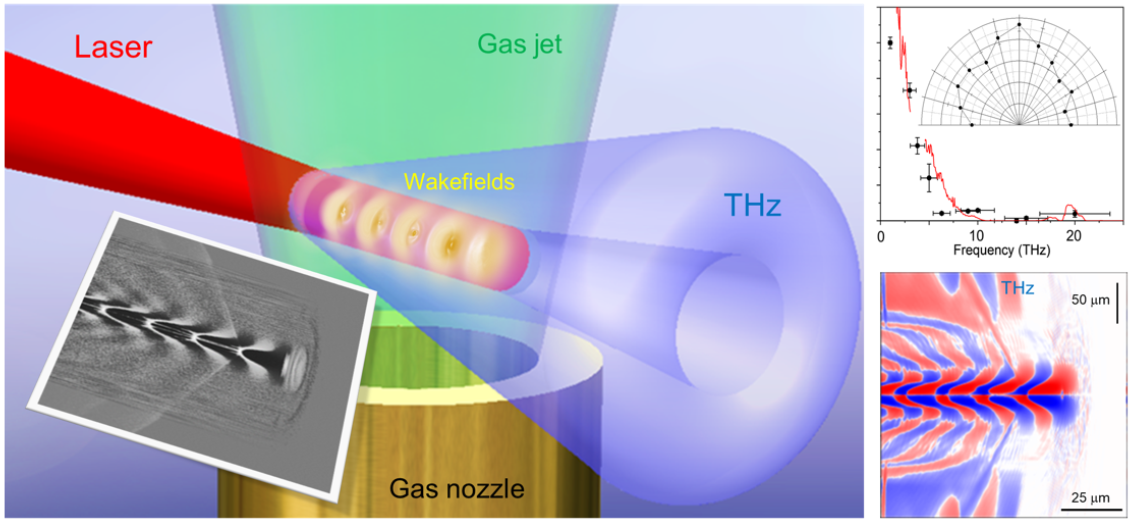| PREVIOUS PRESENTATION | BACK TO PROGRAM OVERVIEW | NEXT PRESENTATION |
Multi-millijoule terahertz emission from relativistic plasmas
T. Pak1, M. Rezaei-Pandari2, C. I. Hojbota3, M. Mirzaie4, H. Kim4, J. H. Sung4, S. K. Lee4, C. Kang4 and K. Y. Kim5
1Deutsches Elektronen-Synchrotron DESY, Notkestraße 85, 22607 Hamburg, Germany
2Laser and Plasma Research Institute, Shahid Beheshti University, Tehran, Iran
3University of Texas at Austin, Austin, Texas, 78712, USA
4Advanced Photonics Research Institute, GIST, Gwangju, 61005, Korea
5Institute for Research in Electronics and Applied Physics and Department of Physics, University of Maryland, College Park, Maryland, 20742, USA
Terahertz (THz) waves, with a frequency band lying between the microwave and infrared regions, have attracted a great deal of interest owing to their applications in spectroscopy, imaging, sensing, communication, astronomical observations, quantum detection, and more [1]. Particularly, high-energy or high-power THz sources are essential to study strong THz-driven phenomena such as nonlinear spectroscopy, harmonic generation, molecular alignment, and can even be used for electron acceleration.
Recently, our research team observed high-peak-power (multi-gigawatt), high-energy (multi-millijoule) THz radiation from a laser-plasma-based compact electron acceleration scheme, also known as laser wakefield acceleration (LWFA). Previously, coherent THz emission was observed from LWFA with a 10-terawatt-class laser [2], but until our study, the output THz energy from LWFA had not exceeded even a microjoule level, and no energy scaling had been studied with more powerful drivers.
By using a 100-terawatt laser in our experiment, we observed several millijoules of THz waves from LWFA [3]. The emitted THz radiation is radially polarized and broadband, possibly extending beyond 10 THz. Interestingly, we find that high-energy electrons do not necessarily generate high-power THz radiation. Instead, electrons with low energy but high charge can produce strong THz radiation. Furthermore, the THz energy we observed far exceeds, by three orders of magnitude, the energy expected from the current theory of coherent transition radiation (CTR)—the radiation emitted by a relativistic electron bunch passing through a plasma-vacuum boundary [2]. To explain these surprising findings, we developed a new coherent radiation model, in which the electrons accelerated by the laser ponderomotive force and subsequent plasma wakefields emit broadband radiation continuously along the laser propagation direction, resulting in phase-matched conical THz radiation in the forward direction [3].
Unlike other laser-plasma sources utilizing solid targets, LWFA-based sources use gases and raise little or no concern about target debris or target reloading. This makes our source favorable for use in high-repetition-rate operation (>1 kHz). Our model also predicts that THz energy at the joule level can be produced from petawatt-scale LWFA. We note, however, our model needs to be examined by more follow-up experiments and analytic/numerical studies, in order to have a full understanding of THz generation mechanism in LWFA, as well as to optimize the source for future high-power THz applications.

Figure 1: Left: A laser pulse ionizes a gas jet and accelerates plasma electrons via LWFA, simultaneously producing phase-matched conical THz radiation in the far field. Right top: Discrete THz spectrum and polarization characterized with metal-mesh bandpass filters and a wire grid polarizer, respectively. Right bottom: Simulated longitudinal electric field distribution in a laser moving box plotted in a symlog scale. The laser propagates from left to right.
References
[1] A. Leitenstorfer et al. J. Phys. D: Appl. Phys. 56, 223001 (2023).
[2] W. P. Leemans et al. Phys. Rev. Lett. 91, 074802 (2003).
[3] T. Pak et al. Light Sci. Appl. 12, 37 (2023).
